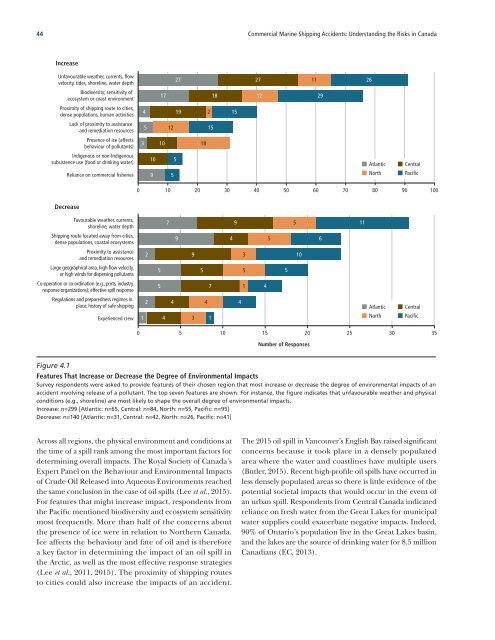Commercial Marine Shipping Accidents Understanding Risks Canada
cca_marine_shipping_risks_en_fullreport
cca_marine_shipping_risks_en_fullreport
You also want an ePaper? Increase the reach of your titles
YUMPU automatically turns print PDFs into web optimized ePapers that Google loves.
44 <strong>Commercial</strong> <strong>Marine</strong> <strong>Shipping</strong> <strong>Accidents</strong>: <strong>Understanding</strong> the <strong>Risks</strong> in <strong>Canada</strong><br />
Increase<br />
Unfavourable weather, currents, flow<br />
velocity, tides, shoreline, water depth<br />
Biodiversity; sensitivity of<br />
ecosystem or coast environment<br />
Proximity of shipping route to cities,<br />
dense populations, human activities<br />
Lack of proximity to assistance<br />
and remediation resources<br />
Presence of ice (affects<br />
behaviour of pollutants)<br />
Indigenous or non-Indigenous<br />
subsistence use (food or drinking water)<br />
Reliance on commercial fisheries<br />
27<br />
27 11 26<br />
17<br />
18 12 29<br />
4 19 2 15<br />
5 12<br />
15<br />
3 10 18<br />
10 5<br />
Atlantic<br />
9 5<br />
North<br />
Central<br />
Pacific<br />
0 10 20 30 40 50 60 70 80 90 100<br />
Decrease<br />
Favourable weather, currents,<br />
shoreline, water depth<br />
<strong>Shipping</strong> route located away from cities,<br />
dense populations, coastal ecosystems<br />
Proximity to assistance<br />
and remediation resources<br />
Large geographical area, high flow velocity,<br />
or high winds for dispersing pollutants<br />
Co-operation or co-ordination (e.g., ports, industry,<br />
response organizations); effective spill response<br />
Regulations and preparedness regimes in<br />
place; history of safe shipping<br />
7<br />
9 5 11<br />
9<br />
4 5 6<br />
2 9 3 10<br />
5<br />
5 5<br />
5<br />
5 7 1 4<br />
Experienced crew<br />
2<br />
4 4 4<br />
1 4 3 1<br />
Atlantic<br />
North<br />
Central<br />
Pacific<br />
0 5 10 15 20 25 30 35<br />
Number of Responses<br />
Figure 4.1<br />
Features That Increase or Decrease the Degree of Environmental Impacts<br />
Survey respondents were asked to provide features of their chosen region that most increase or decrease the degree of environmental impacts of an<br />
accident involving release of a pollutant. The top seven features are shown. For instance, the figure indicates that unfavourable weather and physical<br />
conditions (e.g., shoreline) are most likely to shape the overall degree of environmental impacts.<br />
Increase: n=299 [Atlantic: n=65, Central: n=84, North: n=55, Pacific: n=95]<br />
Decrease: n=140 [Atlantic: n=31, Central: n=42, North: n=26, Pacific: n=41]<br />
Across all regions, the physical environment and conditions at<br />
the time of a spill rank among the most important factors for<br />
determining overall impacts. The Royal Society of <strong>Canada</strong>’s<br />
Expert Panel on the Behaviour and Environmental Impacts<br />
of Crude Oil Released into Aqueous Environments reached<br />
the same conclusion in the case of oil spills (Lee et al., 2015).<br />
For features that might increase impact, respondents from<br />
the Pacific mentioned biodiversity and ecosystem sensitivity<br />
most frequently. More than half of the concerns about<br />
the presence of ice were in relation to Northern <strong>Canada</strong>.<br />
Ice affects the behaviour and fate of oil and is therefore<br />
a key factor in determining the impact of an oil spill in<br />
the Arctic, as well as the most effective response strategies<br />
(Lee et al., 2011, 2015). The proximity of shipping routes<br />
to cities could also increase the impacts of an accident.<br />
The 2015 oil spill in Vancouver’s English Bay raised significant<br />
concerns because it took place in a densely populated<br />
area where the water and coastlines have multiple users<br />
(Butler, 2015). Recent high-profile oil spills have occurred in<br />
less densely populated areas so there is little evidence of the<br />
potential societal impacts that would occur in the event of<br />
an urban spill. Respondents from Central <strong>Canada</strong> indicated<br />
reliance on fresh water from the Great Lakes for municipal<br />
water supplies could exacerbate negative impacts. Indeed,<br />
90% of Ontario’s population live in the Great Lakes basin,<br />
and the lakes are the source of drinking water for 8.5 million<br />
Canadians (EC, 2013).


